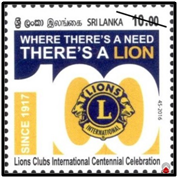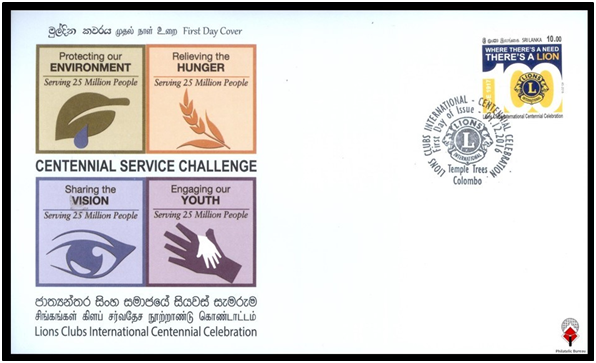

Home/Active Page

Sri Lanka Philatelic Bureau of the Department of Posts has issueda commemorative stamp in the denomination of Rs. 10.00 on 01st December 2016 to commemorate the Centennial Celebration of Lions Clubs International.
| Date of Issue: | 01st December 2016 |
| Denomination: | Rs.10.00 |
| Catalogue No. | CSL 2193 |
| Stamp Designer. | Mr.IsuruChathuranga |
| Sheet Composition: | 20 stamps per sheet |

In 1917, Melvin Jones, a 38-year-old Chicago business leader, told members of his local business club they should reach beyond business issues and address the betterment of their communities and the world. Jones' group, the Business Circle of Chicago, agreed.
After contacting similar groups around the United States, an organizational meeting was held on June 7, 1917, in Chicago, Illinois, USA. The new group took the name of one of the invited groups, the "Association of Lions Clubs," and a national convention was held in Dallas, Texas, USA in October of that year. A constitution, by-laws, objectives and a code of ethics were approved. And the rest is history.
1917: Melvin Jones and fellow Chicago businessmen found Lions Clubs to improve the community.
The first convention takes place at the Adolphus Hotel in Dallas, TX.
1920: Lions Clubs become international by chartering a club in Windsor, Canada.
1925: During the international convention in Cedar Point, Ohio, Helen Keller charges Lions with becoming "knights of the blind in the crusade against darkness."
1926: Polar explorer and member of the Washington D.C. Lions Club, Admiral Richard E. Byrd, Jr. flies over the North Pole and carries the Lions flag with him. He flies over the South Pole later that same year.
1930: Lion George Bonham paints a cane white with a wide red band to aid the visually impaired after he witnesses a blind man having trouble crossing the street.
1931: Lions head south and establish a club in Nuevo Laredo, Mexico.
The first international convention outside of the U.S. is held in Toronto, Ontario, Canada.
1933: Visitors to the Chicago World's Fair learn about Lions clubs at the fair's Social Science Division.
1935: Amelia Earhart, honorary member of the New York City Lions Club, completes a record-breaking nonstop flight from Los Angeles to Mexico during the Lions Clubs International Convention in Mexico City.
Local Lions donate a Talking Book machine to the Milwaukee Public Library, allowing the blind to hear books.
1939: Members of the Detroit Uptown Lions Club turn an old Michigan farmhouse into a school to train dog guides for the visually impaired, helping to popularize dog guides worldwide.
To provide an organized baseball program for children, Lion Carl Edwin Stotz of Williamsport, Pennsylvania, appeals for support from Lions clubs, YMCAs and other community partners. On June 6, 1939, the very first Little League baseball game is played at Park Point in Williamsport.
1944: The world's first eye bank is created in New York City. Today, most eye banks are Lions-sponsored.
1945: Lions assist in drafting the United Nations Charter, starting a lasting bond with the U.N.
1946: The Lions Blind Camp on Casper Mountain in Wyoming hosts its first group of blind children.
1947: In October, Lions celebrate the 30th anniversary of the association at the Waldorf Astoria Hotel in New York City. It had become the world's largest service club organization at the time with 324,690 members in 19 nations.
Lions are given consultant status with the U.N. Economic and Social Council.
1948: Only three years after World War II, Europe sees its first Lions club in Stockholm, Sweden. Geneva, Switzerland, follows suit just days later.
A Lions club is formed in Kalaupapa on the island of Molokai, Hawaii. Kalaupapa is a leper colony and the charter members all have Hansen's disease (leprosy).
1952: Filipino Lions reach out to Japan and encourage the chartering of the first Japanese Lions club.
1954: After an international contest among Lions, an official motto is chosen: "We Serve." The motto was submitted by Lion D. A. Stevenson of Font Hill, Ontario, Canada.
1956: The Detroit Lions Club gives 6-year-old Stevie Wonder a Christmas gift – a drum set.
The Amundsen-Scott South Pole Station is built. Soon after, 16 scientists and military personnel charter the 59ers Lions Club there.
1957: Lions launch youth programs, including the very successful Leo Clubs.
1965: Lions build the Melvin Jones Lions International Memorial in Fort Thomas, Arizona.
1968: The Lions Clubs International Foundation (LCIF) is established. Since its founding, LCIF has given more than US$826 million in grants to support the humanitarian work of Lions.
1971: LCI moves to its fourth and final location in Oak Brook, IL, after decades in downtown Chicago.
1972: LCIF sends out its first grant – US$5,000 to assist victims of flooding in South Dakota.
1973: In February, the association welcomes its one millionth member.
1977: Lion Jimmy Carter, a peanut farmer from Georgia, becomes president of the United States of America.
1985: LCIF awards its first Major Catastrophe Grant of US$50,000 for earthquake relief in Mexico.
1986: Mother Teresa accepts the Lions Humanitarian Award.
1987: The association amends its bylaws and invites women to become members. Women are now the fastest growing segment of new members.
1990: SightFirst is launched, eventually raising more than $415 million dollars to help eradicate major causes of blindness.
French Lion Michael Baury helps build an electric traction car and races it at a Grand Prix event.
1995: LCIF partners with The Carter Center, led by former US president and Lion Jimmy Carter, to combat river blindness in Africa and Latin America.
1999: NiloferBakhtiar of Pakistan is elected as the first female international director of the association.
2001: LCIF and Special Olympics partner on Opening Eyes, an initiative to screen the vision of Special Olympics athletes.
2002: Lions charter two clubs in China, the nation's first voluntary membership group since the 1950s.
2003: Through SightFirst, Lions and The Carter Center record their 50 millionth river blindness treatment.
2004: Lions mobilize more than US$15 million for South Asia tsunami relief following the disaster.
2007: The Financial Times ranks LCIF as best non-governmental organization worldwide to partner with.
2010: The Bill & Melinda Gates Foundation contributes US$5 million to the One Shot: One Life campaign, and Lions raise more than US$10 million to support measles efforts over the next two years.
2011: LCIF awards its 10,000th grant – bringing the total amount awarded to US$708 million.
Lions help administer 148 millionth dose of Mectizan to treat river blindness.
Following the Japan earthquake and tsunami, Lions mobilize over US$21 million for relief efforts.
2013: LCIF partners with the GAVI Alliance to protect millions of children from measles and rubella. LCIF commits US$30 million for immunizations, matched by US$30 million from UK Government and Bill & Melinda Gates Foundation, bringing the total to US$60 million.
Colombia eliminates river blindness with the support of Lions and The Carter Center partnership.
Engaging our Youth
Support youth in your community, or inspire the next generation of volunteers by inviting Leos and other local youth to serve on a project with you.
Sharing the Vision
Prevent future cases of unnecessary blindness through vision screenings and educational events. Give the gift of sight through projects that benefit those who are blind or living with low vision.
Relieving the Hunger
Improve access to healthy food for vulnerable populations in your community.
Protecting our Environment
Protect and improve the environment to make your community a healthier place to live for everyone.
All rights received. All right to identify the Department of Posts as the Author and designer of this Bulleting has been asserted in accordance with the Copyright, Design and Patents Act 1988.No part to this publication may be reproduced, stored in or introduced into a retrieval system, or transmitted in any form or by and means (electronic, mechanical, photocopying, recording or otherwise) without the prior permission from the publisher. Any person who does and unauthorized act in relation to this publication may be liable to criminal prosecution and civil claims for damages.